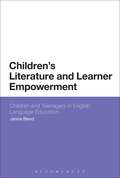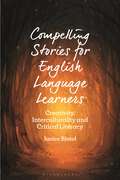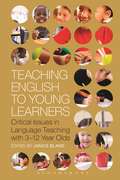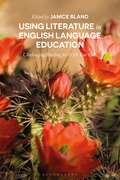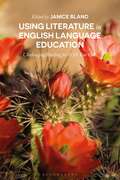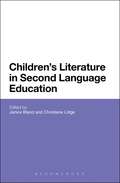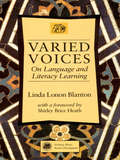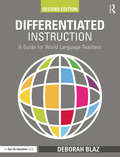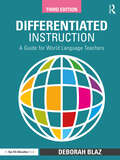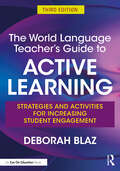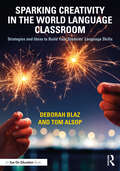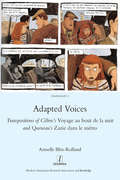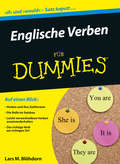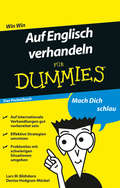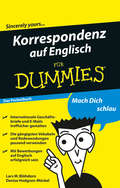- Table View
- List View
Children's Literature and Learner Empowerment: Children and Teenagers in English Language Education
by Janice BlandChildren's literature can be a powerful way to encourage and empower EFL students but is less commonly used in the classroom than adult literature. This text provides a comprehensive introduction to children's and young adult literature in EFL teaching. It demonstrates the complexity of children's literature and how it can encourage an active community of second language readers: with multilayered picturebooks, fairy tales, graphic novels and radical young adult fiction. It examines the opportunities of children's literature in EFL teacher education, including: the intertexuality of children's literature as a gate-opener for canonised adult literature; the rich patterning of children's literature supporting Creative Writing; the potential of interactive drama projects. Close readings of texts at the centre of contemporary literary scholarship, yet largely unknown in the EFL world, provide an invaluable guide for teacher educators and student teachers, including works by David Almond, Anthony Browne, Philip Pullman and J.K.Rowling. Introducing a range of genres and their significance for EFL teaching, this study makes an important new approach accessible for EFL teachers, student teachers and teacher educators.
Children's Literature and Learner Empowerment: Children and Teenagers in English Language Education
by Janice BlandChildren's literature can be a powerful way to encourage and empower EFL students but is less commonly used in the classroom than adult literature. This text provides a comprehensive introduction to children's and young adult literature in EFL teaching. It demonstrates the complexity of children's literature and how it can encourage an active community of second language readers: with multilayered picturebooks, fairy tales, graphic novels and radical young adult fiction. It examines the opportunities of children's literature in EFL teacher education, including: the intertexuality of children's literature as a gate-opener for canonised adult literature; the rich patterning of children's literature supporting Creative Writing; the potential of interactive drama projects. Close readings of texts at the centre of contemporary literary scholarship, yet largely unknown in the EFL world, provide an invaluable guide for teacher educators and student teachers, including works by David Almond, Anthony Browne, Philip Pullman and J.K.Rowling. Introducing a range of genres and their significance for EFL teaching, this study makes an important new approach accessible for EFL teachers, student teachers and teacher educators.
Compelling Stories for English Language Learners: Creativity, Interculturality and Critical Literacy
by Janice BlandThis book is a comprehensive and thorough introduction to children's and young adult literature in English language education. Reading is promoted as central to language education in order to experience perspectives from around the world, and the book demonstrates the many opportunities for teaching with compelling story, encouraging an active and engaged community of second language readers through challenging picturebooks, motivating graphic novels, dynamic plays, enchanting verse novels and compelling young adult fiction. Using many examples of literary texts that are well suited to the primary or secondary classroom, the book focuses on the advantages of deep reading and the vital importance of in-depth learning. In-depth learning is an approach that involves the students as motivated participants, working collaboratively and with empathy while preparing for and confronting the challenges of the 21st century. Illustrating the approach with a Deep Reading Framework based in research and theory, Janice Bland guides the reader to discover and learn how to make use of literary texts in a way that challenges students to become involved in interculturality, creativity and critical literacy. Throughout the book the emphasis is on an approach that puts the reader and language learner in the centre – not a study of literature but a study of how readers learn through compelling story.
Compelling Stories for English Language Learners: Creativity, Interculturality and Critical Literacy
by Janice BlandThis book is a comprehensive and thorough introduction to children's and young adult literature in English language education. Reading is promoted as central to language education in order to experience perspectives from around the world, and the book demonstrates the many opportunities for teaching with compelling story, encouraging an active and engaged community of second language readers through challenging picturebooks, motivating graphic novels, dynamic plays, enchanting verse novels and compelling young adult fiction. Using many examples of literary texts that are well suited to the primary or secondary classroom, the book focuses on the advantages of deep reading and the vital importance of in-depth learning. In-depth learning is an approach that involves the students as motivated participants, working collaboratively and with empathy while preparing for and confronting the challenges of the 21st century. Illustrating the approach with a Deep Reading Framework based in research and theory, Janice Bland guides the reader to discover and learn how to make use of literary texts in a way that challenges students to become involved in interculturality, creativity and critical literacy. Throughout the book the emphasis is on an approach that puts the reader and language learner in the centre – not a study of literature but a study of how readers learn through compelling story.
Teaching English to Young Learners: Critical Issues in Language Teaching with 3-12 Year Olds
by Janice BlandAimed at student teachers, educators and practitioners, Teaching English Language to Young Learners outlines and explains the crucial issues, themes and scenarios relating to this area of teaching. Each chapter by a leading international scholar offers a thorough introduction to a central theme of English as a foreign language (EFL) with preteens, with clear presentation of the theoretical background and detailed references for further reading, providing access to the most recent scholarship. Exploring the essential issues critically and in-depth, including the disadvantages as well as advantages of Teaching English as a Foreign Language (TEFL) with young learners, topics include: - task-based learning in the primary school;- storytelling;- drama;- technology;- vocabulary development;- intercultural understanding; - Content and Language Integrated Learning (CLIL) scenarios;- assessment.Innovative and rapidly emerging topics are covered, such as immersion teaching, picturebooks in the EFL classroom and English with pre-primary children.
Teaching English to Young Learners: Critical Issues in Language Teaching with 3-12 Year Olds
by Janice BlandAimed at student teachers, educators and practitioners, Teaching English Language to Young Learners outlines and explains the crucial issues, themes and scenarios relating to this area of teaching. Each chapter by a leading international scholar offers a thorough introduction to a central theme of English as a foreign language (EFL) with preteens, with clear presentation of the theoretical background and detailed references for further reading, providing access to the most recent scholarship. Exploring the essential issues critically and in-depth, including the disadvantages as well as advantages of Teaching English as a Foreign Language (TEFL) with young learners, topics include: - task-based learning in the primary school;- storytelling;- drama;- technology;- vocabulary development;- intercultural understanding; - Content and Language Integrated Learning (CLIL) scenarios;- assessment.Innovative and rapidly emerging topics are covered, such as immersion teaching, picturebooks in the EFL classroom and English with pre-primary children.
Using Literature in English Language Education: Challenging Reading for 8–18 Year Olds
by Janice BlandCovering Green's The Fault in Our Stars, Collins' The Hunger Games, Selznick's The Invention of Hugo Cabret, Rowling's Wizarding World, Staake's Bluebird and Winton's Lockie Leonard, contributors consider how literature can be used for teaching literary literacy, creative writing, intercultural learning, critical pedagogy and deep reading in school settings where English is the teaching medium. Leading scholars from around the world explore pedagogical principles for English Language Teaching (ELT) widening children's and teenagers' literacy competences as well as their horizons through insightful engagement with texts. From challenging picturebooks for primary and secondary students, to graphic novels, to story apps, film and drama, as well as speculative fiction on provocative topics, recent research on literature education in ELT settings combines with cognitive criticism in the field of children's, young adult and adult literature.
Using Literature in English Language Education: Challenging Reading for 8–18 Year Olds
by Janice BlandCovering Green's The Fault in Our Stars, Collins' The Hunger Games, Selznick's The Invention of Hugo Cabret, Rowling's Wizarding World, Staake's Bluebird and Winton's Lockie Leonard, contributors consider how literature can be used for teaching literary literacy, creative writing, intercultural learning, critical pedagogy and deep reading in school settings where English is the teaching medium. Leading scholars from around the world explore pedagogical principles for English Language Teaching (ELT) widening children's and teenagers' literacy competences as well as their horizons through insightful engagement with texts. From challenging picturebooks for primary and secondary students, to graphic novels, to story apps, film and drama, as well as speculative fiction on provocative topics, recent research on literature education in ELT settings combines with cognitive criticism in the field of children's, young adult and adult literature.
Children's Literature in Second Language Education
by Janice Bland Christiane LütgeBringing together leading scholars and teacher educators from across the world, from Europe and the USA to Asia, this book presents the latest research and new perspectives into the uses of children's literature in second language teaching for children and young adults. Children's Literature in Second Language Education covers such topics as extensive reading, creative writing in the language classroom, the use of picturebooks and graphic novels in second language teaching and the potential of children's literature in promoting intercultural education. The focus throughout the book is on creative approaches to language teaching, from early years through to young adult learners, making this book an essential read for those studying or embarking on second language teaching at all levels.
Children's Literature in Second Language Education
by Janice Bland Christiane LütgeBringing together leading scholars and teacher educators from across the world, from Europe and the USA to Asia, this book presents the latest research and new perspectives into the uses of children's literature in second language teaching for children and young adults. Children's Literature in Second Language Education covers such topics as extensive reading, creative writing in the language classroom, the use of picturebooks and graphic novels in second language teaching and the potential of children's literature in promoting intercultural education. The focus throughout the book is on creative approaches to language teaching, from early years through to young adult learners, making this book an essential read for those studying or embarking on second language teaching at all levels.
Varied Voices: On Language and Literacy Learning
by Linda Lonon Blanton"I can say with certainty that this book will add a compelling sense of depth and texture to the existing body of research in first and second language literacy." --Patricia Richard-Amato, California State University at Los Angeles Varied Voices is an ethnographic study of language and literacy learning in a culturally and linguistically diverse Moroccan school. There, children and teachers turn classrooms into social spaces as they work to build learning communities. Suitable for MATESOL courses and in-service training, Varied Voices is a must-read for all instructors working with language minority students at the elementary and secondary school levels.
Varied Voices: On Language and Literacy Learning
by Linda Lonon Blanton"I can say with certainty that this book will add a compelling sense of depth and texture to the existing body of research in first and second language literacy." --Patricia Richard-Amato, California State University at Los Angeles Varied Voices is an ethnographic study of language and literacy learning in a culturally and linguistically diverse Moroccan school. There, children and teachers turn classrooms into social spaces as they work to build learning communities. Suitable for MATESOL courses and in-service training, Varied Voices is a must-read for all instructors working with language minority students at the elementary and secondary school levels.
Differentiated Instruction: A Guide for World Language Teachers
by Deborah BlazIn this new edition of a bestseller, author Deborah Blaz helps you differentiate lessons for your world language students based on their learning styles, interests, prior knowledge, and comfort zones. This practical book uses brain-based teaching strategies to help students of all ability levels thrive in a rigorous differentiated learning environment. Each chapter provides classroom-tested activities and tiered lesson plans to help you teach vocabulary, speaking, listening, reading, and writing in world language classes in ways that are interactive, engaging, and effective for all learners. Features new to this edition include: Sample thematic units to make your lessons more authentic and immersive New strategies for using technology to differentiate world language instruction Additional checklists, rubrics, and feedback forms to help you organize your lesson plans and track students’ progress New connections to the Common Core State Standards, the ACTFL Standards, Webb’s Depth of Knowledge, and Bloom’s Taxonomy You’ll also learn how to differentiate assessment effectively to help all students show their full potential. Classroom-ready tools and templates can be downloaded as free eResources from our website (www.routledge.com/9781138906181) for immediate use.
Differentiated Instruction: A Guide for World Language Teachers
by Deborah BlazIn this new edition of a bestseller, author Deborah Blaz helps you differentiate lessons for your world language students based on their learning styles, interests, prior knowledge, and comfort zones. This practical book uses brain-based teaching strategies to help students of all ability levels thrive in a rigorous differentiated learning environment. Each chapter provides classroom-tested activities and tiered lesson plans to help you teach vocabulary, speaking, listening, reading, and writing in world language classes in ways that are interactive, engaging, and effective for all learners. Features new to this edition include: Sample thematic units to make your lessons more authentic and immersive New strategies for using technology to differentiate world language instruction Additional checklists, rubrics, and feedback forms to help you organize your lesson plans and track students’ progress New connections to the Common Core State Standards, the ACTFL Standards, Webb’s Depth of Knowledge, and Bloom’s Taxonomy You’ll also learn how to differentiate assessment effectively to help all students show their full potential. Classroom-ready tools and templates can be downloaded as free eResources from our website (www.routledge.com/9781138906181) for immediate use.
Differentiated Instruction: A Guide for World Language Teachers
by Deborah BlazIn the third edition of a bestseller, author Deborah Blaz helps you differentiate lessons for your world language students based on their learning styles, interests, prior knowledge, and comfort zones. This practical book uses brain-based teaching strategies to help students of all ability levels thrive in a rigorous differentiated learning environment. Each chapter provides classroom-tested activities and tiered lesson plans to help you teach vocabulary, speaking, listening, reading, and writing in world language classes in ways that are interactive, engaging, and effective for all learners.Features new to this edition include: activities aligned with the latest ACTFL and CEFR standards ideas and activities for project-based learning, virtual learning, and learning with digital tools, such as ChatGPT up-to-date latest guidance on learning styles and using variety in teaching more photocopiable forms, checklists, and handouts for suggested activities You’ll also learn how to differentiate assessment effectively to help all students show their full potential. Classroom-ready tools and templates can be downloaded as free support material from our website (www.routledge.com/9781032258287) for immediate use.
Differentiated Instruction: A Guide for World Language Teachers
by Deborah BlazIn the third edition of a bestseller, author Deborah Blaz helps you differentiate lessons for your world language students based on their learning styles, interests, prior knowledge, and comfort zones. This practical book uses brain-based teaching strategies to help students of all ability levels thrive in a rigorous differentiated learning environment. Each chapter provides classroom-tested activities and tiered lesson plans to help you teach vocabulary, speaking, listening, reading, and writing in world language classes in ways that are interactive, engaging, and effective for all learners.Features new to this edition include: activities aligned with the latest ACTFL and CEFR standards ideas and activities for project-based learning, virtual learning, and learning with digital tools, such as ChatGPT up-to-date latest guidance on learning styles and using variety in teaching more photocopiable forms, checklists, and handouts for suggested activities You’ll also learn how to differentiate assessment effectively to help all students show their full potential. Classroom-ready tools and templates can be downloaded as free support material from our website (www.routledge.com/9781032258287) for immediate use.
The World Language Teacher's Guide to Active Learning: Strategies and Activities for Increasing Student Engagement
by Deborah BlazEnhance your students’ success and improve the likelihood of retention with the easy-to-implement activities and strategies in this book! Bestselling author Deborah Blaz shows how to create a classroom in which students can actively experience and explore a world language. The new edition features updates in every chapter and incorporates the latest ACTFL standards, more information on teaching with authentic resources, a new chapter on teaching with technology, and additional resources for personalized learning. It is organized to allow you to easily find and pull activities you want to use in your classroom the very next day. You’ll learn how to… mix up your repertoire of activities, games, and exercises to keep students engaged; introduce students to the culture of the language you teach by hosting parties and celebrations; overcome some of the biggest obstacles in the path to fluency, including verb conjugation, using object pronouns, and the subjunctive mood; customize your teaching strategies to accommodate a broader range of talents, skills, and intelligences; implement new assessment strategies to improve verbal skills and reading comprehension; and more! Bonus: Downloadable versions of some of the resources in this book are available on the Routledge website at www.routledge.com/9781032258294 so you can print and distribute them for immediate classroom use.
The World Language Teacher's Guide to Active Learning: Strategies and Activities for Increasing Student Engagement
by Deborah BlazEnhance your students’ success and improve the likelihood of retention with the easy-to-implement activities and strategies in this book! Bestselling author Deborah Blaz shows how to create a classroom in which students can actively experience and explore a world language. The new edition features updates in every chapter and incorporates the latest ACTFL standards, more information on teaching with authentic resources, a new chapter on teaching with technology, and additional resources for personalized learning. It is organized to allow you to easily find and pull activities you want to use in your classroom the very next day. You’ll learn how to… mix up your repertoire of activities, games, and exercises to keep students engaged; introduce students to the culture of the language you teach by hosting parties and celebrations; overcome some of the biggest obstacles in the path to fluency, including verb conjugation, using object pronouns, and the subjunctive mood; customize your teaching strategies to accommodate a broader range of talents, skills, and intelligences; implement new assessment strategies to improve verbal skills and reading comprehension; and more! Bonus: Downloadable versions of some of the resources in this book are available on the Routledge website at www.routledge.com/9781032258294 so you can print and distribute them for immediate classroom use.
Sparking Creativity in the World Language Classroom: Strategies and Ideas to Build Your Students’ Language Skills
by Deborah Blaz Tom AlsopJam-packed with inspiring lessons and ideas, this book will help you access and enhance your own creativity in the classroom and inspire your students to become motivated language learners. Top authors Blaz and Alsop share practical strategies to channel your creative impulses and transform them into effective lessons that will energize students of all levels. Aligned with ACTFL (American Council on the Teaching of Foreign Languages) and CEFR (Common European Framework of Reference for Languages) standards, the resources in this book support creativity as a practical process, with step-by-step guidance on goal-setting, implementation, evaluation, and feedback. Examples come from many world languages and cover fun and original topics, including tapping into students’ own interests through cooking, memes, online videos, sports, arts and crafts, and more. Relevant for all levels of language instruction, this text includes plentiful photocopiable charts, templates, and samples to use in the classroom.
Sparking Creativity in the World Language Classroom: Strategies and Ideas to Build Your Students’ Language Skills
by Deborah Blaz Tom AlsopJam-packed with inspiring lessons and ideas, this book will help you access and enhance your own creativity in the classroom and inspire your students to become motivated language learners. Top authors Blaz and Alsop share practical strategies to channel your creative impulses and transform them into effective lessons that will energize students of all levels. Aligned with ACTFL (American Council on the Teaching of Foreign Languages) and CEFR (Common European Framework of Reference for Languages) standards, the resources in this book support creativity as a practical process, with step-by-step guidance on goal-setting, implementation, evaluation, and feedback. Examples come from many world languages and cover fun and original topics, including tapping into students’ own interests through cooking, memes, online videos, sports, arts and crafts, and more. Relevant for all levels of language instruction, this text includes plentiful photocopiable charts, templates, and samples to use in the classroom.
Adapted Voices
by Armelle Blin-RollandVoyage au bout de la nuit (1932), by Louis-Ferdinand Celine (1894-1961), and Zazie dans le metro (1959), by Raymond Queneau (1903-1976), were two revolutionary novels in their transposition of spoken language into written language. Since their publication they have been adapted into a broad range of media, including illustrated novel, bande dessinee, film, stage performance and recorded reading. What happens to their striking literary voices as they are transposed into media that combine text and image, sound and image, or consist of sound alone? In this study, Armelle Blin-Rolland examines adaptations sparked by these two seminal novels to understand what 'voice' means in each medium, and its importance in the process of adaptation.
Adapted Voices
by Armelle Blin-RollandVoyage au bout de la nuit (1932), by Louis-Ferdinand Celine (1894-1961), and Zazie dans le metro (1959), by Raymond Queneau (1903-1976), were two revolutionary novels in their transposition of spoken language into written language. Since their publication they have been adapted into a broad range of media, including illustrated novel, bande dessinee, film, stage performance and recorded reading. What happens to their striking literary voices as they are transposed into media that combine text and image, sound and image, or consist of sound alone? In this study, Armelle Blin-Rolland examines adaptations sparked by these two seminal novels to understand what 'voice' means in each medium, and its importance in the process of adaptation.
Englische Verben für Dummies (Für Dummies)
by Dr. Lars M. BlöhdornDie englischen Verben haben es in sich. Wann wird ein -s angehängt und wann ein -ed? Wie war das noch mal mit if und would? Und welche Unterschiede bei den Verben gibt es zwischen britischem und amerikanischem Englisch? Lars Blöhdorn macht es Ihnen leicht, dort einzusteigen, wo es für Sie die größten Stolpersteine gibt. Leicht verständlich und mit der üblichen Prise Humor erläutert er die Bildung von Zeiten, Konditionalsätzen, Passivformen und indirekter Rede. Und schon verlieren diese grammatischen Ungetüme ihren Schrecken. Sie erfahren, wie Sie zusammengesetzte Verben richtig verwenden, welche idiomatischen Ausdrücke Sie kennen sollten, wie neue Verben gebildet werden und was in der Alltagssprache wichtig ist. Dank der Übungen am Ende eines jeden Kapitels können Sie Ihre Lernfortschritte schnell überprüfen.
Auf Englisch verhandeln fur Dummies Das Pocketbuch (Für Dummies)
by Dr. Lars M. Blöhdorn Denise Hodgson-MöckelNicht jeder, der souverän und erfolreich eine Verhandlung führen kann, fühlt sich auch im Umgang mit englischsprachigen Verhandlungspartnern sicher. Lars M. Blöhdorn und Denise Hodgson-Möckel geben Ihnen die wichtigsten Vokabeln und Redewendungen für Verhandlungen auf Englisch an die Hand. Die Autoren verraten Ihnen auch, wie sie so manche Klippe bei schwierigen Verhandlungen umschiffen können. So können Sie gelassen und gut vorbereitet Ihrer nächsten Verhandlung auf Englisch entgegensehen.
Korrespondenz auf Englisch fur Dummies Das Pocketbuch (Für Dummies)
by Dr. Lars M. Blöhdorn Denise Hodgson-MöckelHaben Sie häufiger mit englischsprachigen Kunden oder Kollegen zu tun? Oder wollen sich auf Englisch bewerben? Lars M. Blöhdorn und Denise Hodgson-Möckel geben Ihnen die wichtigsten Wörter und Formulierungen an die Hand. Von der richtigen Anrede und dem korrekten Aufbau von Angeboten, Reklamationen oder Einladungen über E-Mail-Etikette bis zur englischsprachigen Bewerbung für Ihren Traumjob finden Sie hier alles Wichtige für eine freundliche und verständliche Korrespondenz auf Englisch.
